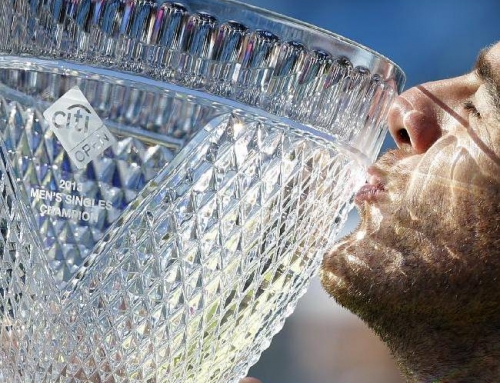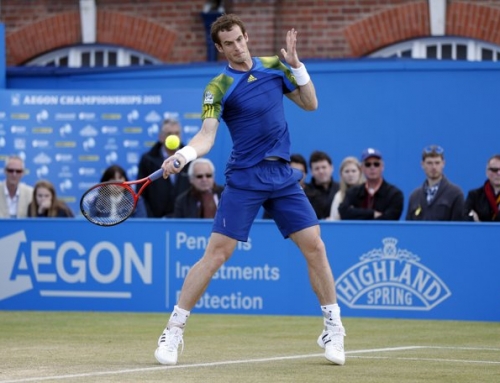 Fresh off his win over Rafael Nadal, Andy Murray teamed up with his brother, Jamie Murray, to win the doubles title over the fourth seed, Cermak and Polasek of the Czech Republic and Slovakia, respectively, in a tidy 6-1, 6-4 win, the easiest win en route to the title. The two had teamed up to win Valencia last year, so this win helps defends the points they earned last year.
Fresh off his win over Rafael Nadal, Andy Murray teamed up with his brother, Jamie Murray, to win the doubles title over the fourth seed, Cermak and Polasek of the Czech Republic and Slovakia, respectively, in a tidy 6-1, 6-4 win, the easiest win en route to the title. The two had teamed up to win Valencia last year, so this win helps defends the points they earned last year.
Meanwhile, in Beijing, Tomas Berdych showed a resurgence in form by winning the Beijing title. Cilic took the first set 6-3, but Berdych came back to take the the second set 6-4. From the looks of it, Berdych was serving first and was up a break (which should have lead to a 6-3 second set) so Cilic must have broke but got broken back. Berdych took the third set easily, 6-1.
This is Berdych’s first title of the year. While he had two outstanding Slams in 2010, Berdych has played remarkably steady if not spectacular tennis this year. He’s lost in 7 quarterfinals and 6 semifinals for 13 tournaments where he’s reached at least the quarterfinals. Berdych is playing his best tennis of the year which is nice because he was suffering from a similar injury to Djokovic (a shoulder injury) that caused him to withdraw from Cincy and retire in a match against Tipsarevic at the US Open.
And quickly, a few comments on the Murray match against Nadal.
Murray has played Nadal four times this year losing all four. Two were on clay (Monte Carlo, French Open) and the others were in Slams (Wimbledon, US Open). His losing streak to Nadal extends back to the year-end championship where he lost in the semis to Rafa in a long match that may have helped Federer take the title.
The last time Murray beat Rafa was in Toronto. At the time, Murray decided on hitting big against Nalbandian (who was having a mini-resurgence in quality of play), then took Nadal (who looked rusty) in the semis, and Federer in the finals.
To beat Rafa again, Murray has had to go back to the drawing board and add to his list of weapons. No other player has pushed Murray to get better than Nadal. I believe Murray feels if he can beat Nadal, he can beat Federer and Djokovic.
To this end, Murray has really added to his arsenal. In particular,
- Murray is hitting a huge flat backhand crosscourt and short. This is his biggest shot and arguably now the biggest backhand in tennis. It’s a testament to Rafa’s skills that he can hit this ball.
- Murray has beefed up his down the line backhand. Murray has always been more comfortable hitting crosscourt than down the line, but he needs the down the line shot for the same reason Djokovic does. With it, he makes his crosscourt even more potent since he can go either direction.
- Murray is taking a lot of Nadal’s high balls to his backhand on the rise and leaning in. This does two things. Murray has always been accused of playing too defensively. This puts him way behind the baseline and forces Murray to scramble. It’s clearly good to have these skills because Murray still gets in defensive positions from time to time, but his ability to hit on the rise allows him to maintain an aggressive court position.
- Murray is using his down-the-line backhand as an approach shot. He did this at the US Open too but wasn’t nearly as effective. Most players attack the net off a powerful forehand, but it creates an angle that Rafa takes advantage of. Murray is trying to shallow up that angle and Rafa doesn’t have good answers which allows Murray to get reasonable volleys.
- Murray then volleys back behind Nadal. Murray knows that Nadal is one of the quickest players on tour and even a simple crosscourt volley to the open court is not so simple. Murray chose to do this to force Rafa to have to change direction and produce a weak pass. You can see that Murray has worked hard on his net game including half volleys and he’s starting to get good at it. His touch is starting to be remarkable.
- Murray has added more topspin to his forehand. One of Murray’s earliest ideas to beat Nadal was the short crosscourt forehand. The reason is Nadal’s desire to hit forehands when he can. The short crosscourt forehand leaves the ball short enough that Nadal can’t run around and hit his forehand. However, Murray sometimes gets in trouble when Nadal attacks his forehand. Murray tends to hit a flatter ball and this was leading to errors. Murray has added more spin to his forehand so when he gets pressured on the forehand he has enough loop to pull the ball back in. He even used it to advantage on approaches where balls that appeared to be heading out curled back on the line.
- Murray has beefed up his inside-out forehand. This is a move straight out of the Federer playbook. Federer has long used his inside out forehand to create winners against most opponents. Murray used this to great effect in the second set. He backed off the angle in the third set and hit a somewhat shallower angle in the third. I think he’ll need to get more confident in this shot so he can be on the offensive more.
- Murray is more willing to hit a huge crosscourt backhand off the wide serve in the ad court. Federer criticized Djokovic for hitting huge on match point down, but Djokovic turned the match off that huge hit and rattled Federer. Murray realizes he needs big shots on returns to make the difference.
Despite all the strategic changes, part of an entire Murray package to beat Nadal, Murray had to also win a psychological battle. Murray was unable to hold his serve off the bat. Despite opportunities to break, Murray couldn’t turn the first set around. What Murray has discovered is that you need to bully Nadal. Murray knows that he doesn’t put a lot of first serves in. He wouldn’t have reached number 4 in the world without a penchant for holding serve despite a lot of second serves.
Murray had to battle hard to get a break on Nadal early in the second set, then battle just as hard to hold serve. The critical games to reach 3-1, then 4-1 was huge. Once Murray reached 4-1, he was on a high and Nadal was left reeling, but until he secured that 4-1 lead, Nadal was very much in the match. Once 4-1 was achieved, and this was after Murray let himself down a 0-40 hole, then three aces, then still saving another break point, and finally a long series of exchanges for a hold, then Murray started to believe he could take it to Nadal. Nadal won only one more game the rest of the match.
Murray’s strategy revolved around a Federer-like strategy, keeping points pretty short. I don’t think there was a 20 point shot in the match. Give credit to Nadal for his willingness to play the retriever. This has to be a tiring style to play. Most players, other than Djokovic, play Nadal with power, because they know to play too passively allows Nadal to control the point and dictate play. Djokovic is the only player to play a bit like Nadal and try to outlast Nadal off long, long rallies. Murray prefers to outhit Nadal, but this requires amazing timing. Djokovic plays a “safer” way to beat Nadal, but the disadvantage is the sheer amount of time Djokovic stays on court to get the win. Murray has to believe his way, although prone to more errors, will save wear and tear on his body.
The question for Murray has to be whether he can maintain this style of play in Slams. Djokovic has built a portfolio of wins over Nadal to build a psychological edge. It’s good for Djokovic (who believes he can win) and bad for Nadal (who second guesses himself). For now, Murray has yet to beat Rafa consistently enough that Rafa can’t chalk this loss to Murray zoning.
Murray is, alas, unlikely to play this style all the time. I think Murray is concerned that this style of play is too wearying for most players and that it’s prone to injury and error. Time and again, you see Murray going back to his usual style of play against most other players. He had a wrist injury many years ago, and I think he feels that he could end up like del Potro (losing a year to injury) if he plays this hard all the time even if, in principle, he could shorten a lot of matches this way.
We’ll see what happens in Shanghai and how Nadal and Murray handle that tournament.



![[Basel] del Potro wins Basel over Federer for second consecutive year](https://www.essentialtennis.com/wp-content/uploads/2013/10/20131028delpo-500x383.jpg)


